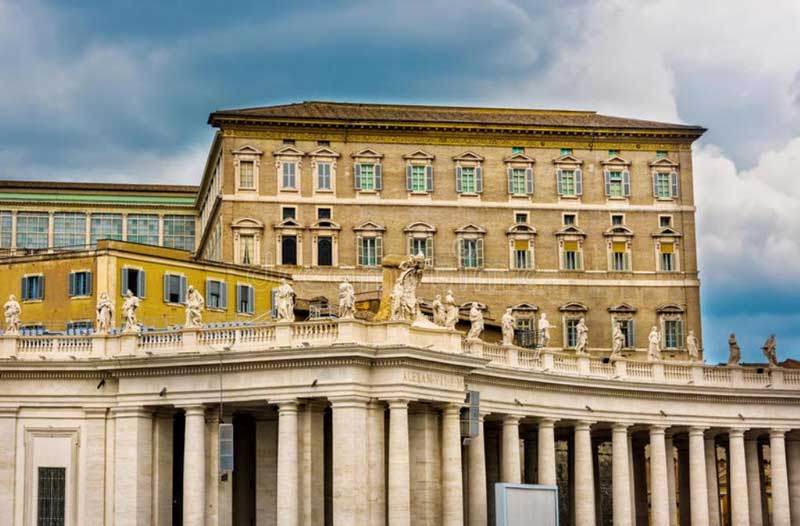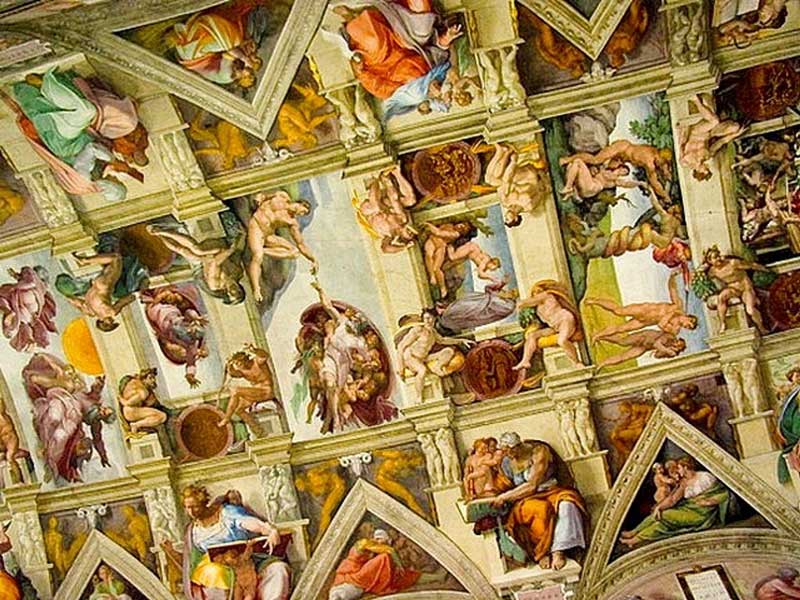
Located in Vatican City the Apostolic Palace is the official residence of the pope, the head of the Catholic Church. Also known as the Papal Palace, Vatican Palace, and the Palace of the Vatican, the building contains the Papal Apartments, offices of the Catholic Church, Vatican Museums, the Vatican Library, and the Holy See, the universal government of the Catholic Church.
Apart from that, it also contains the Sistine Chapel, Raphael Rooms, Borgia Apartment, and different private and public chapels. However, some other parts of the palace, such as a chapel called Cappella Paolina, Sala Regia, the Regal Room that separates Cappella Paolina from the Sistine Chapel, and the Scala Regia, the Regal Staircase, a part of the formal entrance to the Vatican, remain close to tourists.

The Lateran Palace, formally the Apostolic Palace of the Lateran, was the principal residence of the popes from the fourth century that continued so for about a thousand years, until the Apostolic Residence ultimately moved to the Vatican. At that time, a papal palace was built by Pope Symmachus, in the fifth century, close to the Old St Peter’s Basilica, as an alternative residence to the Lateran Palace, and a second fortified palace was built by Pope Eugene III, which was later extensively modified under Pope Innocent in the twelfth century.
Between 1309 and 1376, seven successive popes resided in Avignon, rather than in Rome, due to the conflict between the papacy and the French crown. After returning to Rome in 1377, the popes resided first at Basilica di Santa Maria in Trastevere, and then at Basilica di Santa Maria Maggiore.

By that time, the Vatican Palace became dilapidated and irreparable due to lack of upkeep, and the Lateran Palace had faced two disastrous fires in 1307 and 1361, which made it a scrap. Around one and a half-century later, in 1447, Pope Nicholas razed the ancient fortified palace built by Eugene III to construct a new papal palace, the present Apostolic Palace.
The construction of the Apostolic Palace, covering a huge area of 1,743,753 square feet (162,000 square m), took place mainly between 1471 and 1605. However, the construction of the current version of the magnificent palace began much later, during the reign of Pope Sixtus V, on the 30th of April 1589, and was completed by his successors. Located northeast of the St Peter’s Basilica, the Apostolic Palace is actually a sequence of buildings, arranged around the Courtyard of Sixtus V.

Until 1870, the Quirinal Palace served as a papal residence and housed the central offices responsible for the civil government of the Papal States. Later, it was transformed into one of the presidential residences of the Italian Republic. Today, like the White House of the United States, the Apostolic Palace in Vatican City is not only used for religious purposes but for the general administration of the Vatican, which includes its political, economic, and social responsibilities as a State. The building of the palace, decorated with numerous frescoes, sculptures, and works of art, housed the papal residence from the beginning. The Papal Apartments consisting of private, state, and religious apartments are located on two sides of the third or the top floor of the Apostolic Palace.

Apart from the pope's bedroom in the corner of the building, along with a dining room, a small living room, and the kitchen, the apartments include about ten large rooms including a vestibule, a medical suite equipped with arrangements for emergency surgery, the pope’s private study, and a small studio office for the papal secretary. The papal study window, second from the right, known as the Angelus window, is the one from which every Sunday and on solemn occasions, the pope appears at noon to recite the Angelus prayer and bless the faithful. A red and gold velvet cloth with the papal coat of arms is hung from the window on special solemn occasions.

The second floor of the building includes the luxurious appartamento nobile or the noble apartment, used for the private audiences with the heads of state, the refined del tronetto or the small throne room, the library, and the Hall of the Consistory, where Benedict XVI announced his renunciation. Sala Clementina or the Clementine Hall, notable for its large collection of frescos and other art, is used for events with large gatherings. Besides, the floor also houses the Redemptoris Mater Chapel, the jewel of contemporary art, decorated with mosaics, created by the Jesuit father Ruonik in 1999.

A suite of rooms in the Palace formed the Borgia Apartments, adapted by Pope Alexander VI for his personal use. He commissioned the Italian painter Bernandino di Betto, popularly known as Pinturicchio, to lavishly decorate the rooms with frescoes in the late 15th century. Executed between 1402 and 1494, the frescoes were drawn with themes from medieval encyclopedias with inner meaning signifying the resurrection of the dead, the Last Judgment, the messianic era and the allied, along with celebrating the supposedly divine origins of the Borgias that established roots in Italy and became prominent in ecclesiastical and political affairs in the 1400s and 1500s. After the death of Alexander VI, Julius II abandoned the apartment as he did not like the idea of being surrounded by the memories of his predecessor, and moved to the corresponding room on the floor above, now known as the Raphael Rooms.

Among the various chapels, St Peter Chapel, St Michael Chapel, and St Stephen Chapel, date from the time of Pius V, were decorated with paintings by Vasari, while the Chapel of the Swiss Guards was painted by Giulio Mazzoni and Daniele da Volterra. Other than that, the Hall of Countess Matilda, built during the period of Pope Urban VIII, and subsequently renamed Matilda Chapel, was decorated by the French artist Pietro da Cortona. However, the most celebrated among the chapels, the Sistine Chapel, famous for its brilliantly decorated ceiling, and the Raphael Rooms decorated with frescoes by Raphael and his team of artists are two other most remarkable and integral parts of the Apostolic Palace.
For details about those two, interested persons may visit Sistine Chapel, Vatican Cityand Raphael's Rooms.